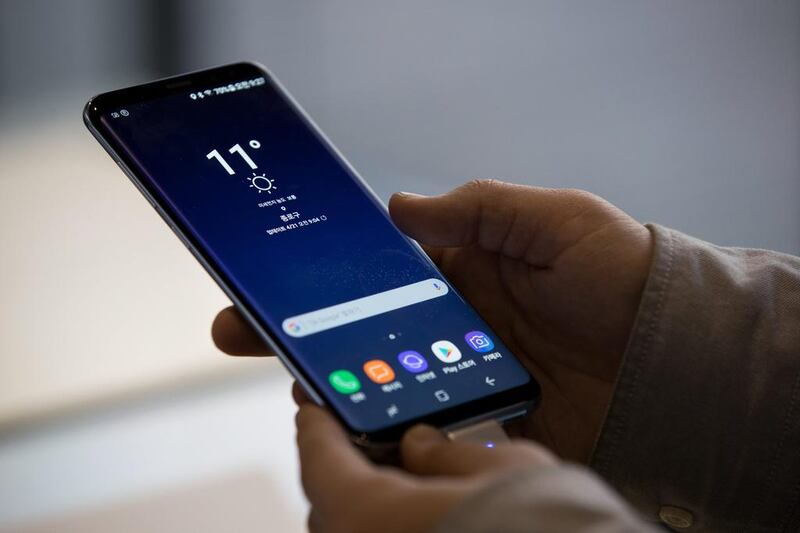It is a shame that Samsung’s Galaxy Note 7 ended up a failed product last year because of its faulty battery.
It was a great smartphone that had everything going for it: powerful specifications; solid features; and a sleek look.
The good news about the Galaxy S8, available in the UAE this week from Dh2,799, is that it picks up where its flawed predecessor left off. Barring another unforeseen fiasco, it should do much to help erase the sting of the Note 7.
The bad news about the S8, and its slightly larger cousin the S8+, is that it does feel like a bit of a rushed product. More on that shortly, but first, the good.
There is no doubt the 5.8-inch S8 and 6.2-inch S8+, which are virtually identical beyond their slightly different sizes, have the best-looking screens of any smartphones produced yet. The Super Amoled “Infinity Displays” are wondrous to look at, with 529 pixels per inch and 16 million colours.
Photos and videos look fantastic and are further enhanced by some under-the-hood software tricks. The screen itself also feels nice to the touch. Combined with the optics, it is a very satisfying phone to hold in your hand.
The redesign also helps in that regard. Samsung has tweaked the S8 and S8+, the device used for this review, so that they are taller and thinner. The bezel has been almost completely eliminated, so the surface is almost all screen.
The extra tallness takes some getting used to, but the new skinniness makes the S8 easier to use one-handed, as is the case with the LG G6.
Samsung has also toned down the screen’s curves, to the point where your fingers no longer slip off the edges when typing. Count me among those who have absolutely hated curved screens for that reason, but the S8 may finally have won me over.
The better design means the S8 now benefits from the curved aesthetic without interfering with usability. Now, if only Samsung could get rid of the dubiously useful Edge toolbar on the side of the screen …
The camera on the S8 is also fantastic, producing similar if not better results than the doomed Note 7. The 12-megapixel camera is the same on paper as last year’s best in class Galaxy S7, but Samsung says it has tweaked some of the behind-the-scenes processing to deliver better results.
It is a believable claim because the S8 produces amazing photos, on par with the Google Pixel, widely believed to have the best smartphone camera on the market right now. The S8’s front camera is also better than that of the S7, getting a boost up to eight megapixels from five. It can now take wide-angle selfies, a neat feature for Snapchatters.
Battery life has also been improved, with 3,000 milliamps providing more than enough juice to get through each day I have been testing. That is particularly impressive considering the power needed to run so much screen.
In a nutshell, the Galaxy S8 excels in the basic functions that most people buy smartphones for. However it is not without one or two flaws.
Samsung announced just before launch that the S8’s most heralded feature, the Bixby voice assistant, would not initially work. Without specifying reasons, the company merely said the functionality would be added at a later time. That is pretty strong evidence the S8 was rushed to launch.
More proof is the poorly thought-out placement of the fingerprint sensor, which now resides on the back of the phone next to the camera. Making the S8 all-screen obviously necessitated the relocation, but there is nowhere worse Samsung could have put it. It is now very easy to smudge the camera – one of the phone’s best features – while fumbling to unlock it. It annoyed me enough to turn off the sensor altogether.
The S8 has several unlock alternatives, including an iris sensor and facial recognition. They mostly work, but they fail just enough to frustrate you into also turning them off. Bewilderingly, Samsung has made it very difficult to easily unlock the S8.
With these few obvious hints of rushed design and the Note 7 disaster still fresh in the memory, you cannot help but wonder if Samsung had enough time to do proper quality assurance. In addition, some who pre-ordered the [hone in South Korea complained of a red-tinyed screen.
Could other things go similarly wrong with the Galaxy S8 down the road? We will have to see.
It would also be a shame because all other things considered, the Galaxy S8 – like the Note 7 before it – is a great phone that deserves to be a success.
business@thenational.ae
Follow The National's Business section on Twitter





